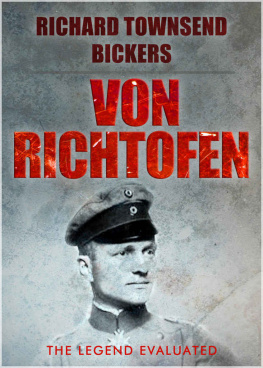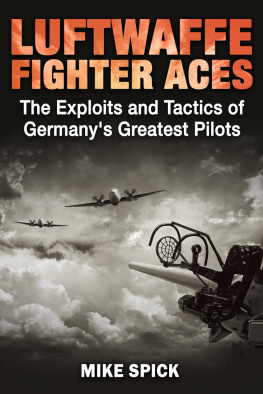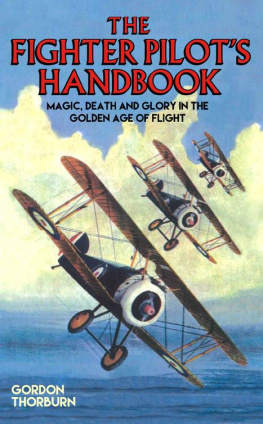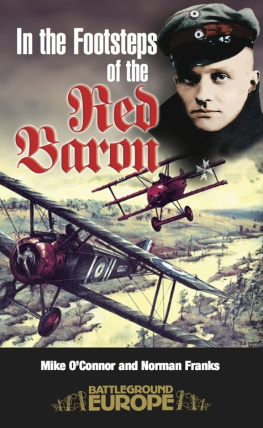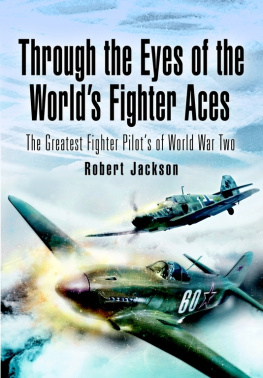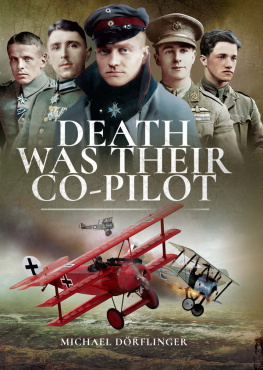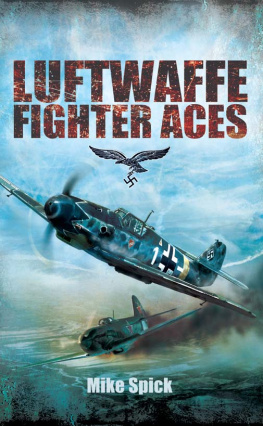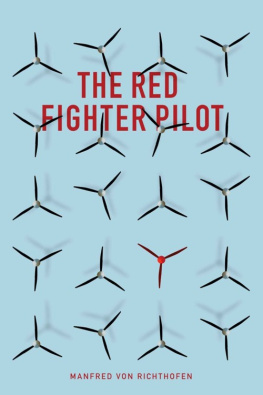VON RICHTHOFEN
THE LEGEND EVALUATED
RICHARD TOWNSHEND BICKERS
Richard Townshend Bickers 1996
Richard Townshend Bickers has asserted his rights under the Copyright, Design and Patents Act, 1988, to be identified as the author of this work.
First published 1996 by Airlife Publishing Ltd.
This edition published by Endeavour Press Ltd in 2014.
Table of Contents
FOREWORD
Rittmeister Manfred Freiherr von Richthofen is a dashing and aristocratic designation that loses nothing in translation: Cavalry Captain Baron Manfred von Richthofen. It well befits the character and short but brilliant life of the man who bore it.
His autobiography, Der Rote Kampflieger , was published in Germany in 1917, many months before his death in action the following year; in America as Red Battle Flyer in 1928 and in France as Le Corsaire Rouge in 1931. He has had German, British and American biographers. He also figures in numerous books on general air operations in the First World War or specifically about fighter aces. Several have been translated from the original languages for foreign publication.
Despite so much attention, he remains not only a complex but also an enigmatic and controversial personality and there is still something fresh to say about him.
He is generally viewed with respect and admiration. The most jaundiced exception is Arch Whitehouse, according to whom, Aggressive though he was, von Richthofen made more than exaggerated claims and never, if he could avoid it, gave credit to a comrade for victory. He was notably jealous of his brother Lothar and disgustingly arrogant before young pilots of his Staffel .
But Whitehouses sour account of his own service on the Western Front as a cavalry trooper and Royal Flying Corps air gunner makes a heavy demand on ones credulity and leaves an unattractive impression of the writer rather than his subject.
This present work is an evaluation of Richthofen as a fighter pilot and leader in comparison with illustrious predecessors, contemporaries and successors of his own and other nationalities; and his influence on air fighting from his own time to the Korean War, after which homing missiles rather than guns have predominated.
The basic principles for a fighter pilot emanate from the brief dictum of Hauptmann Oswald Boelcke, the first great fighter innovator and leader, in 1915. In answer to Richthofens question about what accounted for his outstanding success, he replied, Well, its quite simple. I fly close to my man and aim well, and then of course he falls down. This simplistic statement might have been merely a dismissive or jocular retort, not a concise definition, but it nevertheless expresses the essence of the matter.
In 1917, Leutnant Carl Degelow, who was to be the last recipient of Germanys highest decoration, the Pour le Mrite , confirmed that the essence of victory was To get ever closer, metre by metre even three or four metres. Such proximity suggests a certain rashness: if the enemy aircraft exploded, the attacker could also be blown to bits or his own machine hurled out of control to an almost certain crash. However, caution has never been conspicuous in a fighter pilots nature.
In 1939, Group Captain Sir Douglas Bader KBE, DSO, DFC, one of the greatest fighter pilots and leaders of the Second World War, based his tactics on the methods of the 1914-1918 British pilots of whom he had read as a schoolboy, and cadet at the RAF College, Cranwell. Get as high above your enemy as you can, with the sun behind you, and youll have the advantage. Shoot from as close as possible.
Group Captain A.G. Sailor Malan DSO, DFC, whom many of his most distinguished comrades have rated highest among World War Two fighter leaders, set out the following Ten Commandments in 1940.
1. Wait until you see the white of his eyes. Fire short bursts of one to two seconds, and only when your sights are definitely on.
2. Whilst shooting think of nothing else. Brace the whole of the body, have both hands on the stick, concentrate on your ring sight.
3. Always keep a sharp look-out, keep your finger out.
4. Height gives you the initiative.
5. Always turn and face the attack.
6. Make your decision promptly. It is better to act quickly, even though your tactics are not of the best.
7. Never fly straight and level for more than thirty seconds in the combat area.
8. When diving to attack, always leave a proportion of your formation above to act as top guard.
9. INITIATIVE, AGGRESSION, AIR DISCIPLINE and TEAM WORK are words that MEAN something in air fighting.
10. Go in quickly Punch hard Get out!
Had Richthofen been alive then, by which time weaponry had been much improved, and aircraft performance and the size of fighter and bomber formations had greatly increased, we can be sure that he would have given the same advice as Bader and Malan. He was already practising and teaching some of these principles.
To assess his skill as a fighter pilot in comparison with his contemporaries and those of later generations, there is the evidence of his record and the types of enemy aircraft he destroyed. To gauge his influence over his comrades, the verbal comments, books, articles and letters by some of them are available. To judge his ability as a squadron or Wing leader and his influence on air fighting and leadership in later wars, he must also be examined for a more profound and rare gift. In his brilliant book, The Ace Factor , Mike Spick identifies this as The ability of the pilot to keep track of events and foresee occurrences in the fast-moving, dynamic scenario of air warfare, known now as Situational Awareness.
This is sometimes a natural talent and sometimes the fruit of experience. Whichever way it is acquired, those who possess it have been the most effective fighter leaders: Manfred von Richthofen was one of them.
CHAPTER 1 - TWO RECORDS IN THE RICHTHOFEN TRADITION
On 1 September 1942, Oberleutnant Hans-Joachim Marseille, commanding a Messerschmitt 109 squadron in the North African desert, gave a fine display of the example set by Manfred von Richthofen a quarter-century earlier.
On the night of 30 August, General Rommel, commanding the Afrika Korps , had launched the attack that he believed would finally defeat General Montgomerys Eighth Army. The land battle was supported on both sides by bombing. At 7.30 two mornings later, Marseille, leading the fighter escort, joined a formation of Ju87 dive bombers. There were no other aircraft in sight until, nearly an hour later, he warned his pilots that he had spotted the enemy approaching and above. Ten minute dots that swiftly grew bigger, the official report says.
The Messerschmitts were at 3,500 metres. As soon as the Stukas began their dive, Marseille put his machine into a climbing turn to the right and called, Im attacking.
The account continues, In a twinkling, his No. 2 saw him swing to the left, position himself behind the last of the suddenly scattering Curtiss P40s [Kittyhawks] and shoot at a range of 100 metres. The enemy aeroplane lurched abruptly on to its left wingtip and, burning, fell like a stone vertically to the ground. The time was 8.20.
Like their predecessors in the First World War, German pilots aircraft recognition was poor. So, apparently, was this lots arithmetic. The aircraft were Hurricanes of No. 1 Squadron South African Air Force; and there were twelve of them.
The Ju87s had bombed, so the escort went down to stay with them. At 8.30, according to his No. 2, Marseille shot down another alleged Kittyhawk in flames. Three minutes later, by the No. 2s timekeeping, his leader despatched a third and the flames from burning wreckage lit the desert.
While Marseille and his wing man had broken off to deal with the intruders, the rest of the escort had stayed with the bombers. One of them now gave another alarm: Spitfires! This time the identification was correct. Six, belonging to 92 Squadron, swept down on the two 109s from above and astern. One Spitfire opened fire with cannon and machine-guns and tracer glittered past Marseille. He turned tightly, climbing; his opponent overshot and he was now on its tail. At 80 metres range he shot it down. The time, said his winger, was 8.39.
Next page
